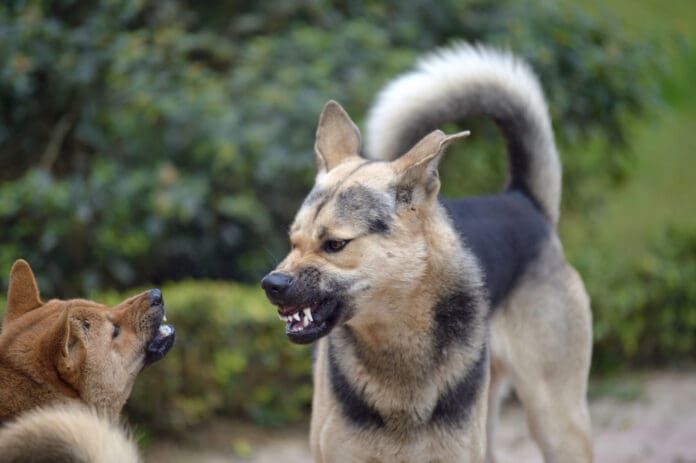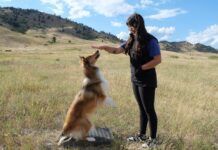Fights amongst dogs living in the same home are common and can be a very scary experience for dog guardians and their dogs. Dog fights can vary in severity from relatively mild, consisting mostly of noise (barking and growling) and minimal, if any, injuries, through to severe, resulting in serious injuries and even death.
As a Certified Applied Animal Behaviourist (CAAB), I’ve helped many pet parents re-introduce dogs after a fight. The good news is that, in most cases, the successful re-introduction of the dogs is possible. That said, in some cases reintroduction is either not possible, for safety and welfare reasons, or is unsuccessful in which case rehoming or behavioural euthanasia is the kindest option.
Firstly, let’s try to understand why dogs fight in the first place.
Why Do Dogs Fight?
It’s important to understand that aggression is a normal part of the canine behavioral repertoire and serves an important function in terms of canine communication. However, its expression is highly undesirable. Aggression is influenced by the environment, biology, and prior learning and, consequently, its expression varies significantly among individuals[1].
There are several reasons why dogs living in the same home might fight. One of the most common reasons is competition for access to high value resources (e.g. food, treats, toys, beds, attention, etc). When two dogs both value the same resource highly, they are more likely to compete to gain access to it. Over-excitement and proximity in confined spaces have also been identified as risk factors[2].
I have personally observed that two dogs closely matched in age and size are more likely to compete for resources compared to two dogs of different ages and sizes. Two female dogs living in the same home are more likely to fight compared to a male/male or male/female combination[2], as are littermates; known as littermate syndrome [2]. The onset of social maturity is another contributing factor often triggering fighting between dogs living in the same home. Similarly, I have also witnessed that a dog reaching old age can result in the onset of dog fights as older dogs are often less adept at reading the other dog’s body language due to vision loss and cognitive decline.
Research shows that the risk of dog fights increases with age, probably due to experience and the increased likelihood older dogs experience pain due to common health conditions like osteoarthritis[3]. Other risk factors include increasing age at acquisition and number of dogs in the household[1].
How to Stop Dogs from Fighting in the Same Household
The first step to stop dogs from fighting is to physically separate them to prevent any further fighting. This is incredibly important because, generally, the higher the frequency and intensity of the fights, the harder it is to repair the relationship and the greater the risk of injury.
Separation also prevents the aggressor from exhibiting the problem behaviour and avoids further injuries and further fear-provoking interactions with the victim dog2. Crates, muzzles, baby gates, doors, and tethered leads can be very helpful in this situation. However, it’s best to seek expert advice tailored to your individual dogs, situation, and circumstances.
Ensure the dogs are thoroughly examined by a vet to identify and treat any health issues that may have contributed to the aggression.
Next, write down all known triggers for the fighting such as specific resources, attention, over-excitement etc., so the triggers can be removed or avoided. Stopping dogs from fighting in the same home is possible but it takes time, commitment, good management, and behaviour modification training to work to help them to get along.
How to Get Dogs to Get Along
Helping dogs living in the same home to get along after a fight typically involves separating them, both physically and visually, initially and then gradually reintroducing the dogs during short training sessions using desensitization and counter-conditioning. This process of gradual exposure paired with high value treats starts to build a positive association between the dogs over time, helping to repair their relationship. Outside of the training sessions, the dogs must be safely separated.
Triggers for fights, such as high value resources, must be identified and either removed from the environment entirely or provided in a way as to eliminate competition for access.
Research has identified that aggression between dogs living in the same home is less likely to improve when triggers for aggression between the dogs are unpredictable and when the aggressing dog is younger than the victim dog; when people are injured in the process of breaking up dog fights; and when fights occur more frequently than once per week[4].
Do Dogs Hold Grudges?
Whilst it’s difficult to know for sure whether dogs are capable of holding grudges, dogs certainly remember negative or traumatic experiences associated with dog fights, such as painful injuries or needing emergency vet treatment. However, every dog is different and some dogs cope better in the aftermath of a dog fight than others. In my experience as a CAAB, I have seen some dogs bounce back really quickly, while others have been severely impacted and continue to show fearful and anxious behaviour in response to the presence of the aggressor dog for weeks, even months, post-fight.
What’s the Prognosis After a Dog Fight?
For most dogs, the prognosis after a dog fight is generally good, especially if fights are few and far between and the injuries inflicted have been relatively minor. As long as dog guardians are able to commit to safely separate, appropriately manage, and gradually desensitise and counter-condition their dogs appropriately, many will successfully reintroduce their dogs following a dog fight with time and consistency.
If, however, the dogs have had many fights, have caused significant injuries, or cannot be appropriately managed to prevent further incidents, then it’s likely these dogs cannot continue to live together safely. Rehoming or behavioural euthanasia must be considered as the next step in these cases.
If your dogs have been involved in a dog fight it’s important to seek help from a qualified and reputable professional who will thoroughly assess your dogs, the environment, and your circumstances to determine the best path forward.
[1] Matos, R. E., Jakuba, T., Mino, I., Fejsakova, M., Demeova, A., & Kottferova, J. (2015). Characteristics and risk factors of dog aggression in the Slovak Republic. Veterinární medicína, 60(8).
[2] McGreevy, P. D., & Masters, A. M. (2008). Risk factors for separation-related distress and feed-related aggression in dogs: Additional findings from a survey of Australian dog owners. Applied Animal Behaviour Science, 109(2-4), 320-328.
[3] Casey, R. A., Loftus, B., Bolster, C., Richards, G. J., & Blackwell, E. J. (2013). Inter‐dog aggression in a UK owner survey: prevalence, co‐occurrence in different contexts and risk factors. Veterinary Record, 172(5), 127-127.
[4] Feltes, E. S., Stull, J. W., Herron, M. E., & Haug, L. I. (2020). Characteristics of intrahousehold interdog aggression and dog and pair factors associated with a poor outcome. Journal of the American Veterinary Medical Association, 256(3), 349-361.







Behavioral euthanasia??? I think that’s a horrific suggestion.
I’m reconsidering my subscription renewal and I’ve been a member for many years.
I was fostering a female dog that I had been warned would fight with other female dogs. She attacked my female dog several times.
I broke them up each time. I noticed they didn’t fight when I wasn’t home. I gave the foster lots of praise and attention when she wasn’t acting aggressive. I figured she had been starved for attention and never learned how to interact comfortably with other dogs. I was helped by another foster-failure dog that was a very social, playful dog but also a very good fighter. He would playfully goad the female but if she responded aggressively he would back her off. Eventually, she learned how to play.
I still go out of my way to praise her and give her attention at random times and when she engages in playful actions, especially with the other female. So, the fighting problem just went away. She has no reason to fight and gets everything she wants, including attention. Plus, she learned that it’s fun to interact with other dogs.
Behavioral euthanasia is obviusly a last resort and it’s a valid last resort. If a dog is a danger to one or more dogs in the household and can not be managed successfully, it can not stay in that home. If re-homing is not possible that leaves only one option.
We got siblings that were girls as 9 weeks old. We did not know the issues with siblings and especially females. That was our error. There were fights on and off. Then there was one serious fight a few years ago. We made the decision that we would keep them both and separate them at all times. We had them for 7 years before the serious fight happened and we were not going to rehome or euthanize any one. Is it hard to keep them separated at all times-yes. But it is worth it for the love the two of them have shared with us and we are committed to them.